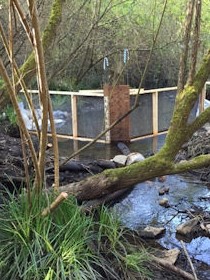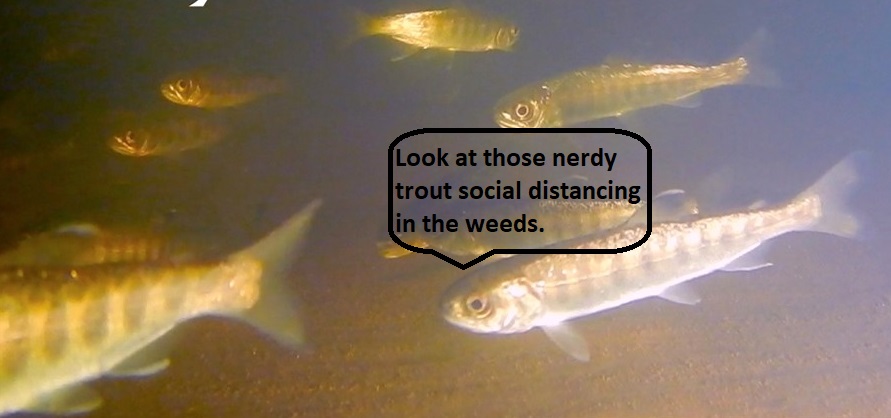2020 Coho Smolt Count Results
 On May 11, the annual Coho smolt count that began on March 16 on Shelly Creek ended with a total count of 3,156 smolts and 13 Trout (2 Cutthroat, 11 Rainbow). The counting was done by Shelley and Carl who maintained a distance of 2 m apart and successfully completed the count with neither of them catching the Coronavirus. YESSSS! It worked! Thank you Shelley and Carl.
On May 11, the annual Coho smolt count that began on March 16 on Shelly Creek ended with a total count of 3,156 smolts and 13 Trout (2 Cutthroat, 11 Rainbow). The counting was done by Shelley and Carl who maintained a distance of 2 m apart and successfully completed the count with neither of them catching the Coronavirus. YESSSS! It worked! Thank you Shelley and Carl.
How does the count compare with other years? Well, this year's Coho smolt number of 3,156 was within the range of 755 to 8,094 smolts counted since the annual smolt trapping program began in 2011. The Trout numbers (13), however, were much lower than expected and the fish were smaller.
Until 2017, Trout numbers ranged between 0 and 60. In 2016, MVIHES removed a large Smolt Counting Fence yellow iris infestation from the Martindale Pond (part of Shelly Creek) where Coho smolts and Trout over-winter. This opened up a lot of open water habitat and in 2017, we counted 153 Trout. In 2018 and 2019 (click here for the report), we counted 296 and 126 Trout, respectively. Could the increase in Trout numbers be due to the increase in open water habitat?
 If so, what happened this year? The Martindale Pond has been filling with sediment from erosion upstream in Shelly Creek and flooding of the Martindale neighbourhood by the Englishman River. The thickness of the sediment layer appears to have increased this year with less free water sitting above the layer. We have also noticed significantly more floating aquatic vegetation in the pond which may be a result of the thicker sediment. Did the reduction in the open water habitat that we gained in 2016, result in less suitable habitat for Trout this year and therefore fewer fish? Measuring a Smolt
If so, what happened this year? The Martindale Pond has been filling with sediment from erosion upstream in Shelly Creek and flooding of the Martindale neighbourhood by the Englishman River. The thickness of the sediment layer appears to have increased this year with less free water sitting above the layer. We have also noticed significantly more floating aquatic vegetation in the pond which may be a result of the thicker sediment. Did the reduction in the open water habitat that we gained in 2016, result in less suitable habitat for Trout this year and therefore fewer fish? Measuring a Smolt
 Or, it could be that the Trout were just socially distancing, unlike the snarky Coho.
Or, it could be that the Trout were just socially distancing, unlike the snarky Coho.
Fortunately, we will be removing sediment from Martindale Pond in late summer in collaboration with a local contractor under a grant from Pacific Salmon Foundation. It is likely the counts in 2021, 2022 and 2023 will determine what impact removing the sediment had on the fish populations.